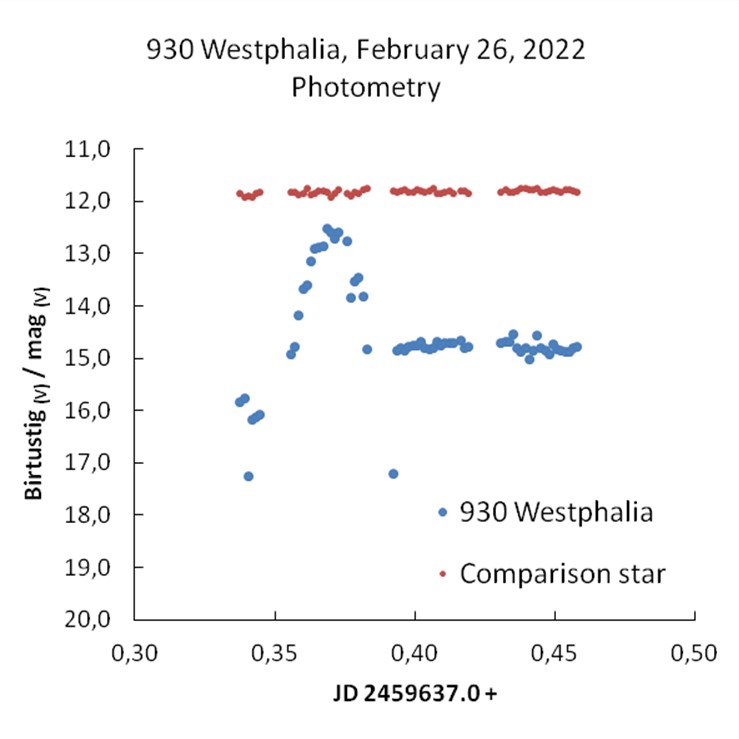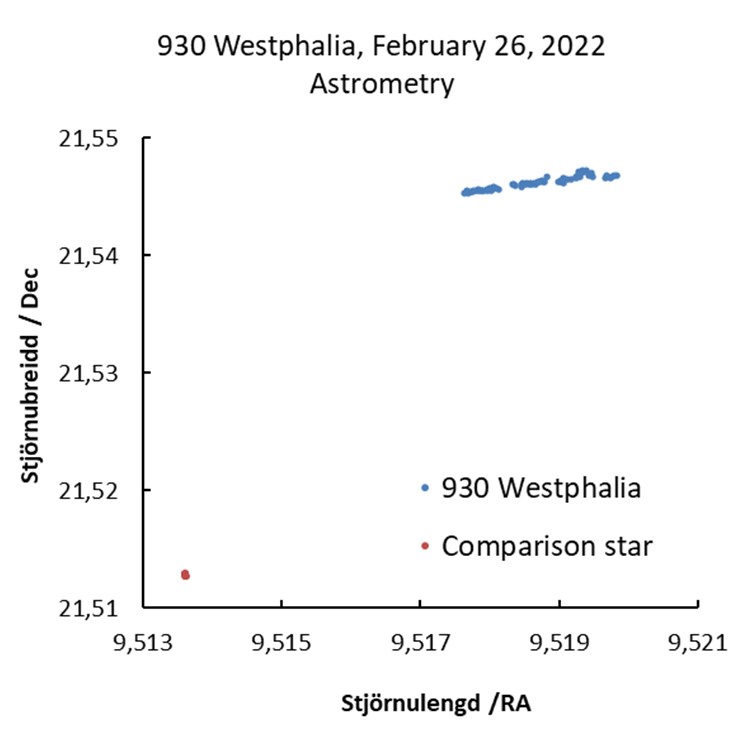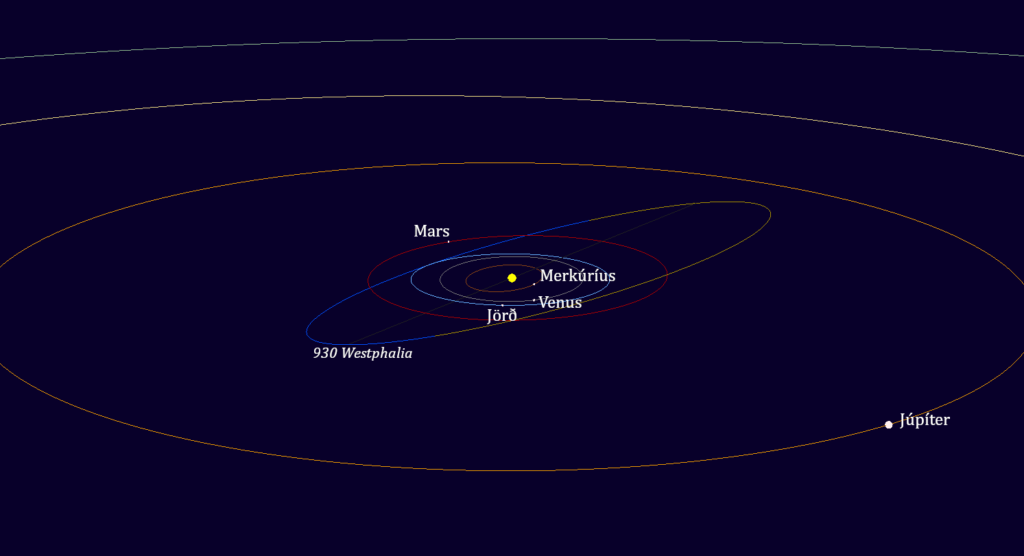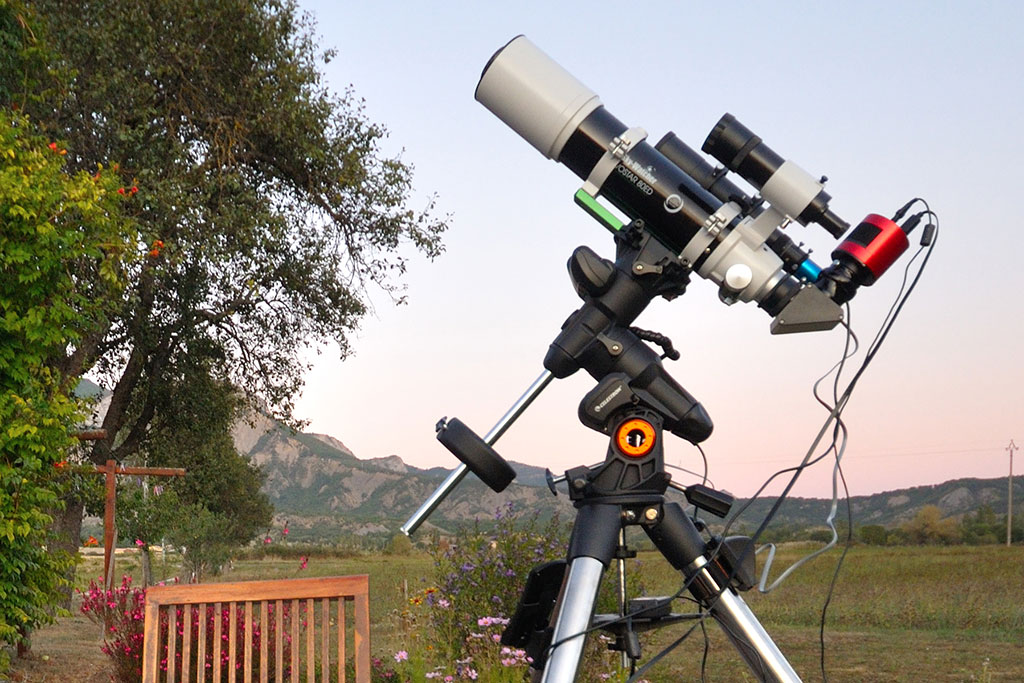Þegar höfundur vefsvæðisins hugðist vinna úr myndefni af stjörnuþokunni NGC 2903 í Ljóninu (mynd 1), sem höfðu verið teknar 26. febrúar 2022, kom í ljós dauft smástirni á meðal stjarnanna. Þetta smástirni, sem er auðkennt 930 Westphalia, uppgötvaði þýski stjörnufræðingurinn Walter Baade (1893-1960), þá starfandi við Bergedorf stjörnustöðina í Hamborg, þann 10. mars 1920. 930 Westphalia er mjög dökkt smástirni og er á sporbraut 2,1 til 2,8 stjarnfræðieiningar frá sólu, í innra svæði smástirnabeltisins. Umferðartími þess er 3,79 ár. Það er flokkað sem kolefniskennt smástirni og er endurkastsstuðull þess um 0,04. Þvermál þess er minna en 40 km.
When the author decided to process his images of the galaxy NGC 2903 in Leo (Figure 1), taken on February 26, 2022, a faint asteroid appeared in the frames. This asteroid, identified as 930 Westphalia, was discovered by German astronomer Walter Baade (1893-1960) at the Bergedorf Observatory in Hamburg on March 10, 1920. 930 Westphalia is a very dark asteroid, orbiting 2.1 to 2.8 AU from the Sun in the inner region of the asteroid belt. Its orbital period is 3.79 years. It is categorized as a hydrated carbonaceous asteroid, and its albedo is 0.04. Its estimated diameter is less than 40 kilometers.

Mynd/Fig. 1. Stjörnuþokan NGC 2903 í Ljóninu. – The galaxy NGC 2903 in Leo.
Ljósmælingar - Photometry
Auðkenni smástirnisins, þ.e. 930 Westphalia, varð staðfest eftir nokkra leit og aðstoð, í leitartóli NASA-JPL; Small-Body Identification Tool (nasa.gov). Samanburður á ætlaðri staðsetningu þess þetta kvöld og hnitsettum myndum höfundar mátuðust fullkomlega.
The asteroid’s identity, i.e., 930 Westphalia, was confirmed after some searching and assistance in the NASA-JPL search tool, the Small-Body Identification Tool (nasa.gov). A comparison of its estimated location that night and the author’s edited photos matched perfectly.
Viðmiðsljósmæling við fimm samanburðarstjörnur gaf birtustigið (bst.) 14,73 ±0,05, þegar athugun fór fram, en samkvæmt leitartólinu var það skráð bst. 15,3. Upplýsingar frá reikistirnastofnun IAU (Minor Planet Center) staðfestir breytileika birtunnar frá 13,1-16,9 í gegnum tíðina.
Differential photometry, based on five comparison stars, indicated the asteroid’s magnitude (mag.) was 14.73 ±0.05, at the time of observation. But according to the identification tool, it was estimated of mag.15.3 at that time. Information from the IAU (Minor Planet Center) confirms variation in brightness from 13.1 to 16.9 throughout time.
Það er athyglisvert að snemma í ferlinu, á meðan myndað var með B litsíu, gekk smástirnið fyrir stjörnuna GSC 1409:1005 (bst. 14.0). Í þvergöngunni virðist heildarbirta hafa aukist töluvert, eins og sést á mynd 2a. Á mynd 2b má sjá að 930 Westphalia hliðraðist rúmar þrjá bogamínútur á þeim þremur tímum sem tökur stóðu yfir.
It is noteworthy that while imaging with the B filter, the asteroid transited the star GSC 1409:1005 (bst. 14.0). During the transit, the combined flux increased considerably, as can be seen in Figure 2a. Figure 2b represents the trajectory, but during the three-hour session, the asteroid moved more than 3 arcminutes.
Mynd 3 sýnir brautarhalla smástirnisins samanborið við brautarfleiti reikistjarnanna.
Figure 3 illustrates the inclination of the asteroid’s orbital plane.

Mynd/Figure 2a. Birta smástirnisins (blá gildi) og samanburðarstjörnu (rauð gildi). Tími á þverás (í JD) og birta á lóðás. – The asteroid’s magnitude (blue dots) and its comparison star (red dots). Time (in JD) is on the x-axis, and flux is on the y-axis.

Mynd/Figure 2b. Hægri myndin sýnir feril smástirnisins. Lengd á þverás, breidd á lóðás. – The right diagram represents the trajectory of the asteroid. The right ascension (RA) is on the x-axis, and the declination is on the y-axis.

Mynd/Figure 3. Skissan, sem var fengin á vefsíðu reikistirnastofnun IAU (Minor Planet Center) sýnir halla sporbrautar 930 Westphalia, samanborið við brautir reikistjarnanna. Litskipting á sporbraut smástirnisins gefur til kynna hvar brautarflötur smástirnisins sker flöt sólkerfisins. Lituðu baugarnir sýna brautir reikistjarnanna, frá Merkúríusi sem er næst sólu út til Neptúnusar. – The sketch, sourced from the IAU (Minor Planet Center) website, shows the inclination of the orbit of asteroid 930 Westphalia in comparison to the orbits of the planets. The colors mark whether the asteroid’s orbital plane is above or below the solar system’s plane. The colored ellipses represent the orbits of the planets, starting with Mercury closest to the sun and extending outward to Neptune.
Þrátt fyrir að hafa ljósmyndað stjarnfyrirbæri í rúm 30 ár hefur smástirni aldrei fyrr komið fram á myndum höfundar. Það varð hvati til þess að útbúa stutt myndband úr kyrrmyndunum, sem teknar voru í Frakklandi 26. febrúar 2022. Vegna þess að þær voru teknar með þrem mismunandi ljóssíum (BVR) er eilítill gæðamunur í myndunum.
Despite having over 30 years of experience in astrophotography, the author has never captured images of asteroids. This motivated the author to create a short video using images taken from France on February 26, 2022, which is presented here. Since the image set shifts between three different filters (BVR), there is some variation in the image quality.
Vegna þess að smástirnið er daufur ljóspunktur í myndunum, gæti reynst erfitt að greina það á litlum tölvuskjá. Þá skaltu stækka myndina yfir allan skjáinn eða horfa á Youtube.
Because the asteroid is only a faint point of light, it might turn out indistinct on a small computer screen. If so, try to use fullscreen mode or watch on YouTube.
Tækjabúnaður - Equipment
Myndir voru teknar með SW 80 ED Evostar lithreinum sjónauka sem er á Celestron AVX GEM sjónaukastæði (mynd 4). Notuð var Zwo Asi 174 MM-C myndavél og myndað í gegnum BVR litsíur, sem eru ætlaðar til ljósmælinga. Alls voru teknar 64 myndir og var tökutími hverrar 2 mínútur.
Images were taken with the SW 80 ED Evostar apochromatic refractor, mounted on a Celestron AVX GEM (Figure 4). The camera was a Zwo Asi 174 MM-C camera, equipped with a set of BVR photometric filters. 64 images were captured using two-minute exposures.

Mynd/Figure 4. Sjónaukinn sem var notaður í gagnaöflun. – The instrument used for data aquisition.